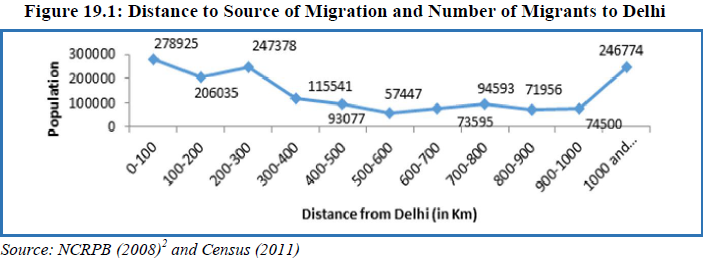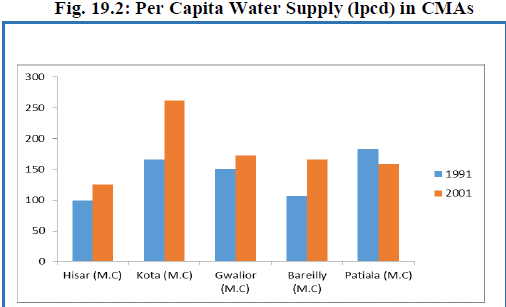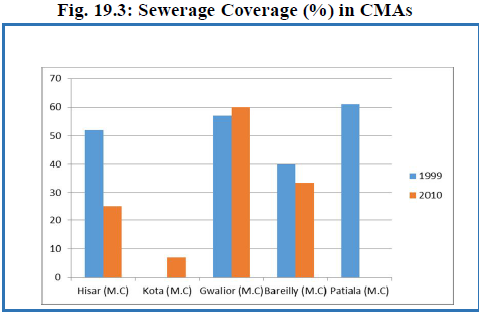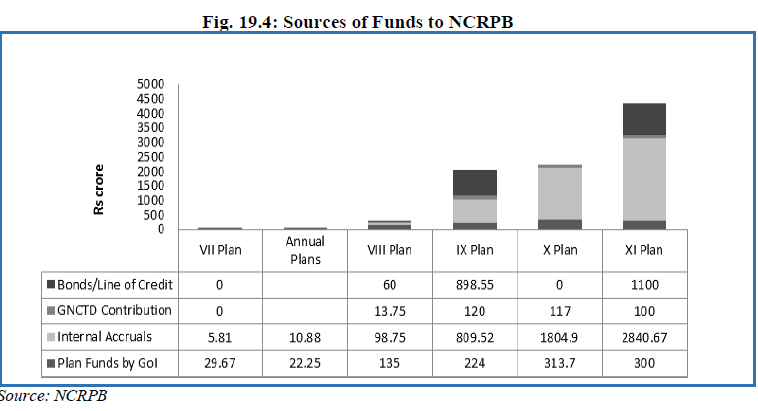National Capital Region (India): ImplementationStrategies, Management Structure & Resource Mobilisation
This article has been sourced from an authoritative, official readers who wish to update or add further details can do so on a ‘Part II’ of this article. |
Contents |
The source of this article
Draft Revised Regional Plan 2021: National Capital Region
July, 2013
National Capital Region Planning Board, Ministry of Urban Development, Govt. of India, Core-4B, First Floor, India Habitat Centre, Lodhi Road, New Delhi-110003
National Capital Region Planning Board
National Capital Region (India): Implementation Strategies Management Structure & Resource Mobilisation
INTRODUCTION
The economic potential of the region can be leveraged through a number of economic drivers - commercial, industrial and services - in the region, as well as the availability of qualified, educated, skilled and mobile populations. However, the NCRPB while promoting regional economic development has to uphold the federal identity of the constituent states.
The benefits of development arising from the rapid urbanisation in NCT-Delhi and the Central National Capital Region (CNCR) metros have not spread evenly to the other parts of the region. While the development of Gurgaon, Faridabad, Ghaziabad and NOIDA has been extremely visible in the cities’ infrastructure status in provision of both physical and social heads has not kept pace with the rapidly rising demand for civic services. The benefits of growth, measured in terms of provision and access to basic infrastructure, have been distributed unevenly, thereby creating environmental stresses. In order to successfully plan for NCR, which is one of the largest metropolitan regions in the world – NCRPB needs to focus on achievable targets, to ensure its policies are effective and driven by consensus and commitment of all its stakeholders.
NCRPB has been given four key functions:
a) To prepare a Regional Plan (RP) for NCR
b) To assist the states in preparing Sub-Regional Plans (SRP) for NCR constituent areas
c) To prepare Functional Plans (FP) for one or more elements of RP such as water, transport, power, etc. depending on regional bearing
d) To arrange for and oversee the financing of selected development projects It is time to recognize the challenges before the NCRPB now that it has reached a significant milestone in the implementation of the RP-2021. Once the state governments have prepared the Sub-Regional Plans, and the NCRPB has prepared Functional Plans, its task should be transformed. The responsibility should shift and the NCRPB should become the harbinger of a long-term vision for the region, along with efficient management and timely implementation of the RP, SRP, and FP. In light of the above, it is time to introspect and plan for the technical, financial and management role that is required by the Board after the SRPs and FPs have been prepared and agreed to. The NCRPB has to become, in this second phase of its mandate, a resource mobilization organization also that facilitates and assists in rolling-out the plans, monitoring the progress and providing assistance.
THE MANDATE OF NCRPB
The National Capital Region Planning Board (NCRPB) was constituted on 28th March, 1985 by the
Box 19.1: Planning for Regional Growth
Even before the creation of the Board, there was recognition of the need for a regional planning approach for Delhi, as outlined in The Interim General Plan for Greater Delhi, 1956 which suggested that ‘serious consideration should be given for a planned decentralisation to outer areas and even outside the Delhi region’. The Master Plan of Delhi 1962 also recognised the need for planning of Delhi in a regional context with a view ‘to achieve a rational growth of Delhi, which has been expanding in a more haphazard way, it is necessary to plan this whole area as a composite unit and have an integrated and balanced overall programme of development. The ring towns must be developed not only to deflect some of the population that would otherwise come into Delhi and jeopardise the planned growth of Delhi but also to help these towns to grow in a planned way’. Similar sentiments were also echoed in the first Regional Plan-2001 published in 1988.
Parliament through the National Capital Region Planning Board Act, 1985 ‘...to provide for the
constitution of a Planning Board for the preparation of a Plan for the development of the National
Capital Region...so as to avoid any haphazard development...’.
The Act, the Board and the Plan serve as the pillars on which regional development is envisaged. To
achieve the mandate envisaged, the Plan provided for two main instruments – Metro and Regional
Centres within the NCR and Counter Magnet Areas (CMAs) outside of the NCR.
While the mandate is clear on the planning role for NCR, the implementation strategy falls short in being able to ensure enforcement of the Plan. Interestingly, the Act specifies that the NCRPB can only ‘coordinate the enforcement and implementation of the Regional Plan, Functional Plans, Sub-Regional Plans and Project Plans through participating States and the Union Territory’.
The ‘coordination’ function of the NCRPB assumes that there is full commitment from all stakeholders to the aims and objectives of RP-2021, and that actions and policies undertaken by State governments and subordinate agencies and organizations would only require coordination, not ‘determination’, ‘definition’, ‘guidance’ or ‘control’. This creates an unnecessary and fractious situation for the NCRPB, which is called upon to point out violations and deviations from the plan, ironically bringing into question both its own efficacy as ‘coordinator’ as well as the commitment of the state governments towards a regional plan prepared by a Board that includes, among others, the Chief Ministers of the constituent states.
In case of violation of the Regional Plan, as per the provisions of the Section 29 (2) of the NCRPB Act 1985, the Board may direct the concerned participating State or the Union Territory to stop such activity and withhold financial assistance to the concerned participating State or the Union Territory. The inherent weakness in this enforcement mandate needs to be revisited.
Under current planning practices, land is ‘notified/reserved’ for development on the basis of a map that has 1:50,000 scale, whereas the land use planning, development and change is practiced at state level. Ideally the Regional Planning at a macro scale should be detailed out in the corresponding Sub-Regional Plans, District Development Plans (DDPs), City Master Plans, etc. Local regulations in the form of Development Control Regulations (DCR) are required to bridge the gap between planning and implementation. These should sufficiently be influenced by the needs of regional integration and common minimum standards. Regulation and enforcement need to address distortions and irregularities caused at micro level and if this is not done then it could lead to weakening of the effectiveness of ‘planning’ done at the regional level. The financial resources available to the Board are also meagre and prevent it from leveraging its strategic position to play an effective role in the planned development of the region. The Parliamentary Standing Committee on Urban Development (2008-09) observed that ‘this [corpus] could hardly benefit the satellite towns and CMAs to be able to work as pull centres which would prevent in-migration into Delhi. In that sense, we have not been able to use this instrumentality. In this context, a substantial enhancement of budgetary support to NCRPB would be of great help’. The means to enhance the NCRPB’s financial resources and leveraging of its planning function are detailed out further in Section 19.6.
OUTCOMES OF REGIONAL PLAN-2021 DURING 2007-12
One of the yardsticks used in the past to measure the success of the Plan has been to alleviate the migration pressures. In an increasingly globalizing world where cities are competing for the best of resources – physical and human – providing employment opportunities and supporting infrastructure become key considerations. Accordingly, this section attempts to assess the performance-to-date through the following parameters:
a) Population trends
b) Service delivery in NCR
c) Service delivery in CMAs
d) Project funding
19.3.1 Population trends in the NCR
The detailed analysis regarding the population trends in NCR has been done in Chapter 4. Uttar Pradesh and Bihar are the major States contributing to the in-migration into NCT-Delhi. While the percentage of migrants from Uttar Pradesh has shown a decrease, it still constitutes the largest share (NCRPB, 2008)1. Bihar exerts a significant influence and seems to challenge the very logic of CMAs. The state of Bihar sends as many migrants to Delhi, as do areas within 100 km and 200 to 300 km from Delhi, yet NCRPB has held that it is far-fetched to invest in Bihar in order to stem the flow of migrants to Delhi. The idea of CMAs rests on the notion that investment in development in distant towns would reduce the ‘pull’ of the metropolitan centre (i.e. NCT-Delhi), and would reduce the ‘push’ away from the less developed town in question. As the next section will show, neither was this levelling out of standards of living achieved nor were these counter-magnets able to exert sufficient ‘pull’ on their own account to attract populations and to keep them resident.
The five CMAs chosen earlier were expected to serve as interceptors of migratory flows into NCR and regional growth centres to achieve a balanced pattern of urbanisation in NCR and even farther afield. However, the population growth rates of CMAs have, on average, declined from 34% to 22% during 1991-2001 compared to 1981-1991. Interestingly, whereas in the case of NCTD, the growth of population in absolute numbers is significant, in the case of CMAs, the statistic that matters is the rate of growth of population. The decline in the growth rates of CMAs also becomes more important, as the majority of the in-migration to Delhi appears to be occurring from the places close to these CMAs. Therefore, there is a definite case to introspect the concept of CMAs.
19.3.2 Service delivery in NCR
A key determinant of balanced regional growth is the adequate and consistent provision of services to the population. The detailed anlaysis on Water and Sewerage has been carried out in Chapter 8 and 9 respectively. The electricity coverage in NCR towns has improved significantly over the last decade but the average is below the NCTD levels. It is widely accepted that power supply and its coverage play a crucial role in the economic growth of the cities and towns. Without proper coverage and efficient supply of power, cities and towns in NCR cannot perform their role as growth engines and employment generators.
19.3.3 Service levels in CMAs
Provision of water supply in the CMAs was at an average rate of 175 lpcd (at production). All the CMA towns have been able to improve/continue the water supply service at par with the Ministry of Urban Development standards.
1 NCRPB (2008), A Study on Counter-magnet Areas to Delhi and National Capital Region 2 NCRPB (2008), A Study On Counter-magnet Areas to Delhi and National Capital Region
While provision of water supply in the CMA was at par with the service standards, more than half of the population do not have access to sewerage network. The coverage of sewerage network has declined from 42% in 1991 to 31% in 2001 in the CMAs. (Fig. 19.2 and Fig. 19.3) While CMA towns have been able to improve the connectivity and accessibility within the towns during 1991-2001, there is still 40% gap in urban road network coverage, when analyzed against the norms specified by the Isher Ahluwalia Committee (2011). These deficits in urban infrastructure do not augur well for cities that are to perform functions as Counter Magnets to NCR. The deficiencies in urban services suggest that there is an urgent need to provide and revamp the infrastructure in these cities with a view to encourage competiveness amongst NCR cities and CMA towns. Most importantly, once migration data is made available for Census 2011, a relook at CMA’s is necessary as existing parameters for CMA’s do not correlate with the socio-economic realities.



